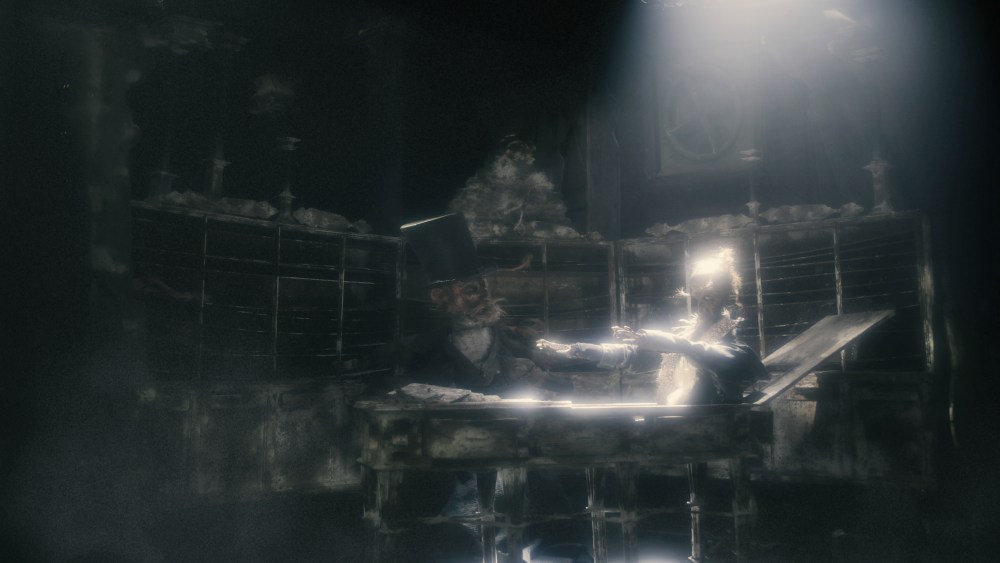‘Sanatorium Under the Sign of the Hourglass’ Review: A Dizzy Fantasia
Time, space and mortality work to no earthly schedule in the half-lit, hand-made twilight world of “Sanatorium Under the Sign of the Hourglass” — so it’s appropriate that this vertiginous stop-motion vision seems to operate by temporal laws of its own. The first feature film in nearly 20 years from cult animators the Quay Brothers runs just 76 minutes, though in the process of watching it, it feels both infinitely longer than that and over in the blink of an eye, like a dream of epic proportions that you forget seconds after waking. This dark, densely nested fairytale of life, death and what comes in between is inspired by the writings of Polish literary titan Bruno Schulz, but with entirely its own collapsing, free-form model of storytelling — driven less by logic than intuitive feeling and ambience, which is where the Quays’ distinctively ethereal visuals come in.
The opaque elusiveness of “Sanatorium” may frustrate viewers who, once drawn into the vividly distressed gothic fantasy of the film’s story world, are cast adrift in a shape-shifting narrative where characters are multiplied, chronologies are bent and fused, and even death isn’t finite. Those more acquainted with the Quays’ work — notably their influential 1986 short “Street of Crocodiles,” also freely adapted from Schulz — will be better prepared for the baroque eccentricities and inscrutabilities of their latest, which premiered in this year’s Venice Days sidebar and is destined for extensive festival play, sparse arthouse distribution and a cultish afterlife. Now in their late seventies, with such celebrity champions as Christopher Nolan in their corner, the Pennsylvania-born, London-based twins still have no designs on the mainstream.
Gorgeously antique-style title cards announce the setting as Sanatorium Karpaty, a mysterious hospice at the foothills of the Carpathian Mountains, in 1937 — the same year Schulz published the novel with which the film shares a title, a Kafkaesque spirit, and more themes than plot points. We must arrive at this milieu, however, via a convoluted framing device involving a sinister auction house. There, recherché items on the block include the petrified ribs of a sea siren, the warm blood of bees and, crucial to the film’s interests, a “Maquette for the Sepulchre of a Dead Retina” — a kind of shadow box animated by a shaft of sunlight on the preserved eye of its former owner, the seven viewing lenses of which proceed to lend the film its seven ornate chapter titles. (The grandiloquence of language throughout feels like the film’s driest running joke.)
It is within the Maquette that the tale unfolds of Jozef (murmuringly voiced by Andrzej Kłak), a stern young man on a winding train journey through a remote stretch of Eastern Europe to the Sanatorium, where his elderly father is either dying or dead, depending on where you are. As the shady overseeing doctor Gotard explains, the facility exists in a time-warp out of kilter with the rest of the universe, somewhere between reality and a dream state: Jozef may find his father alive in one dimension or another, though only via agonized exploration of the vast building’s labyrinthine corridors. Even this description makes “Sanatorium” sound more linear than it is, as Jozef’s journey increasingly breaks down into a psychological maelstrom where memories, nightmares and waking reality become indistinguishable, while the film’s structure and imagery begin to loop in on themselves.
Even as the film becomes harder to parse at a narrative level, however, it continues to provoke a shivery emotional response. Intense grief, terror and desire are all palpable as Jozef spirals into the void, felt through the claustrophobic beauty of the animation — all exquisitely spindly, fragile puppet forms in aged shades of pewter and dust, each frame resembling a long-forgotten steampunk diorama, as reflected in a foxed mirror — and the brittle, haunted-lullaby quality of the score by Timothy Nelson (credited with “music and soundscapes”). Dim lighting and a gauzy, cobwebbed aesthetic ensure we have to concentrate as hard on what we’re looking at as we do on the intricately haywire plotting, though that works to the film’s uncanny quality, as if it were itself a curio fished from an unfamiliar time and place.
The animation, meanwhile, is melded with live-action sequences that feel no less surreal, shot as they are in blurred, distorted fashion to evoke fragments of silent cinema or vintage erotica. Quite where these passages fit into the film’s arcane story design is open to interpretation: Perhaps the human faces here are the stuff of disturbing, untethered imagination for “Sanatorium’s” puppet folk, who somehow look bruised and wounded and corporeal despite their construction of wood, clay and guinea-fowl feathers. Seductive and confounding in equal measure, the Quays’ latest is enough of a trip that our world looks a little stranger when the lights come up and we emerge, blearily blinking, back into it.


